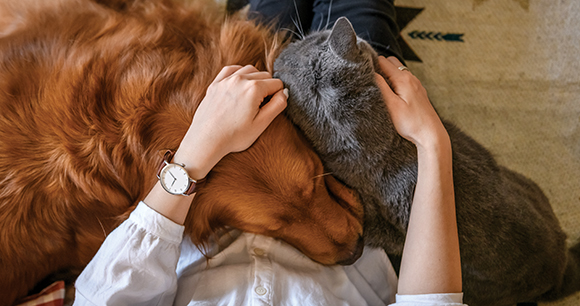by Andrew M. Campbell
Domestic violence continues to impact households and communities around the globe. With an estimated 1 in 3 women and 1 in 4 men suffering physical abuse at the hands of an intimate partner, this far-reaching public health issue claims the lives and well-being of many each year. In addition to risk of harm to humans in homes where this abuse occurs, nonhuman animals (referred to as “animals” for remainder of article) often share in these risks and can become the target of a domestic violence perpetrator.

Animals may be targeted by domestic violence abusers to discourage humans in the home from reporting abuse, ending the relationship, and/or seeking shelter. While much of the research on harm to animals in domestically violent homes focuses on companion animals, in more rural environments, horses, cattle, sheep—any animal with whom human victims find support or comfort—are also likely at risk. Humans impacted by abuse may rely on animals for emotional support when contact with their family and friends becomes limited (domestic violence abusers often work to isolate victims). Animals can become an emotional lifeline for these victims—and this may be particularly true for children in such homes.
An analysis I conducted of children’s involvement in cases of animal cruelty1 indicated that children and animals often share similar circumstances (i.e., abuse victimization or poor health) in homes where abuse occurs. The study reinforced the urgency of removing children from homes in which animal abuse occurs. Among other negative outcomes, children who reside in homes where abuse of animals occurs may be more likely to commit acts of animal cruelty now and in the future.
Failure to protect animals from domestic violence can result in failure to protect the humans connected to them. Victims of domestic violence are unlikely to leave trusted animals behind in a dangerous home environment, and they shouldn’t be forced to choose between their own safety and the well-being of their animals. Domestic violence victims may choose to become homeless or remain in an abusive home environment if no safe place exists to bring their animals.
It is estimated that fewer than 20 percent of domestic violence shelters in the United States currently allow protection for pets on site. While barriers exist to sheltering pets, these barriers do not appear insurmountable. Several organizations are equipped to support domestic violence shelters that are in the process of becoming “pet-friendly.” In the United States, Red Rover and Sheltering Animals and Families Together (SAF-T) are two such organizations that can assist in ensuring domestic violence shelters no longer have to turn animals away. Federal grants under the Protecting Animals With Shelter (PAWS) program are helping service providers expand their assistance to survivors with companion animals.
Among shelters where restrictions do not allow for pets on site, fostering options must be considered. While less optimal than sheltering people and pets together, pet fostering programs still remove an important barrier to victims fleeing an abusive home. Reuniting these pairs as soon as possible is key to ensuring that the healing process will not be disrupted. Continued contact during the foster period can also be of great comfort to victims of abuse—assuring them that their trusted animal companion remains safe as they eagerly await reunification.
While more shelters are opening their doors to companion animals (for a searchable list, see AWI’s Safe Havens Mapping Project), many more are still missing an opportunity to best serve families impacted by abuse. Creating space for animals in domestic violence shelters is critical in getting people-pet pairs to shelter that would otherwise never come. Communities cannot best protect humans from abuse unless they include the animals connected to them in the process.
Andrew Campbell is an expert on family violence and the associated risks of harm for adults, children, and animals residing in homes where this violence occurs. His book Not Without My Pet, covering the pet aspect of family violence, was released September 2021. In addition to being an author, researcher, and educator, Andrew also speaks as a survivor of family violence in childhood.
Not Without My Pet
Pets provide unconditional love—often supporting us during our most vulnerable moments. Too often, however, pets are left out of family violence prevention, detection, and intervention initiatives—including the provision of shelter. Individuals experiencing domestic violence often choose to remain within an abusive home, fearing to stay but afraid to leave a beloved pet alone to face continued abuse and violent acts of retribution.
As a child, author Andrew Campbell survived his own familial abuse in large part due to the support and unconditional love of his pet. His compelling personal story inspired his groundbreaking research about the role that pets play in protecting victims of family violence. Campbell explains how inclusion of pets in family violence prevention plans provides critical support at the very time victims need it most.
1. Campbell, A. M. (2022). The intertwined well-being of children and Non-Human Animals: An analysis of animal control reports involving children. Social Sciences, 11(2), 46. https://doi.org/10.3390/socsci11020046